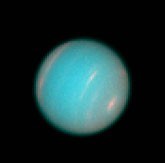The History of
Planet Finding
Since the 1940s, it has been commonly accepted that planets should be
relatively common in space. Unfortunately, 
the limits of science has made it almost impossible to find them until
quite recently. The only planets discovered by
scientists before the 1990s were, of course, Uranus and Neptune (for
ease of reading, we will ignore Pluto as it is
no longer considered a planet). While they are not extrasolar planets
by any means, the discovery of each is
important in understanding how our present-day search began.
Uranus was discovered by William Herschel, an amateur astronomer but
professional musician. Herschel did not set
out to find a planet, but instead merely noticed its movements across
the zodiac during his research. Charles
Messier, a French expert, determined it was not a comet, and William
became famous for first noticing the planet,
though amusingly it was soon determined that Uranus had been observed
infrequently since 1690.
Continued observations of Uranus began to frustrate astronomers, as all
attempts to predict its orbit failed. No path
predicted would be followed for extended periods of time. In the 1830s,
astronomers began to suspect that another
planet was influencing the orbit of Jupiter. In the mid '40s,
mathematics were completed and Neptune was found
through no other means than following the path of its gravity. This
would lay the foundation for the discovery of
extrasolar planets.
In 1990, the first extrasolar planets were discovered orbiting a
pulsar. Because of the peculiarities of a pulsar, each
sends a beam of radio energy to us on a set cycle, at a perfect rate.
This one had irregularities, and it was realized
that just as Uranus' orbit was affected by the gravity of a planet, so
was the spin of pulsar PSR 1257+12. Once
planets were proved possible, the search began, and starting in 1995,
planets were found at an ever-increasing rate.

